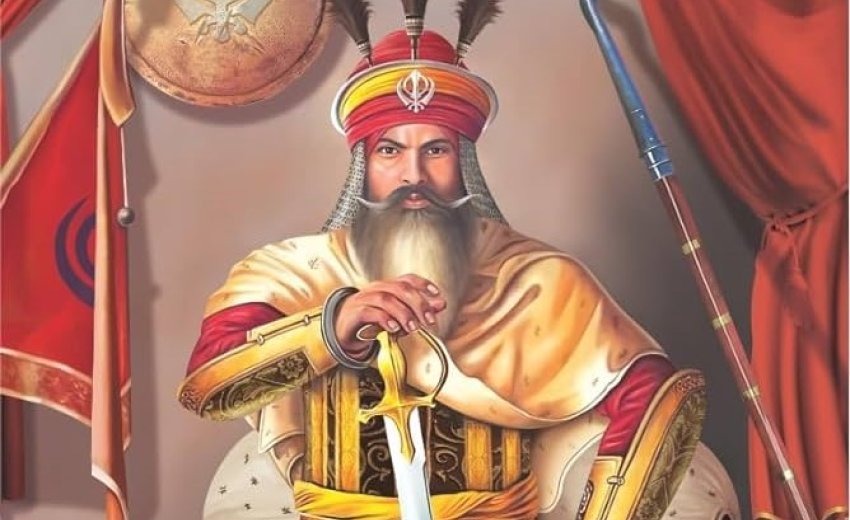Despite the danger, young Hari Singh showed remarkable courage. He managed to grab the tiger's jaw with his hands and pushed it away forcefully.
The resilience of the Afghans in defending their homeland is well-known. Throughout history, whether facing the Soviets in the 1980s or the Americans after 9/11, the Afghans have shown an unwavering ability to resist invaders. Because, regardless of how strong and well-equipped the enemy may be, an Afghan never believes in surrendering territory..
However, there was one notable exception: Hari Singh Nalwa, a commander in Maharaja Ranjit Singh's army, who managed to subdue them. According to legend, Afghan mothers would quiet their babies by taking Nalwa's name, and his reputation instilled fear in young Afghans. This fearsome reputation was so significant that American generals would recount Nalwa's story to inspire their troops during the US-Afghan war.
His Birth
Hari Singh Nalwa was born in 1791 in Gujranwala to Sardar Gurdial Singh and Dharam Kaur. He was their only child. His family originally came from Majitha, a town near Amritsar. His grandfather, Sardar Hardas Singh, served the Sukarchakia Misl, which was also associated with Ranjit Singh. In 1762, Sardar Hardas Singh was killed during a military expedition for the Misl. Hari Singh's father, Gurdial Singh, followed in his father's footsteps. He participated in various campaigns led by Sukarchakia Sardars, Charat Singh and Mahan Singh, in a leadership role. Gurdial Singh passed away in 1798 when Hari Singh was just seven years old. After his father's death, Hari Singh was cared for by his maternal uncle, who took him into his home and looked after him with great care.
Why was Hari Singh called Nalwa when he was actually an Uppal?
During his early service in the Khalsa army, Hari Singh Nalwa experienced a dramatic incident. While on a hunting trip, he was suddenly attacked by a tiger. The attack happened so quickly that Hari Singh didn't have time to draw his sword. Despite the danger, young Hari Singh showed remarkable courage. He managed to grab the tiger's jaw with his hands and pushed it away forcefully. Then, he killed the tiger with his sword. Historian Baron Charles Hugel noted that Hari Singh earned the name "Nalwa" for "cloven the head of a tiger who had already seized him as its prey."
Major conquests of Afghans
Kasur
Hari Singh Nalwa's first major military campaign was in Kasur in 1807. He, along with his fellow commanders, marched on Kasur to subdue its Afghani ruler, Kutab-ud-din Khan. The Sikhs laid siege to the city for three months, after which Kutab-ud-din Khan surrendered. Hari Singh Nalwa was the first to enter the city gates of Kasur with his division, Sher-Dil-Rajman.
Attock
The Battle of Attock in 1813 was fought at the fort of Attock, a key supply point for armies crossing the Indus River. Under the leadership of Dewan Mokham Chand, a general of Maharaja Ranjit Singh, the Sikhs defeated Azim Khan and his brother Dost Mohammad Khan, who fought for Shah Mahmud of Kabul. Alongside Hari Singh Nalwa, other prominent fighters included Hukam Singh Attariwala, Shyamu Singh, Khalsa Fateh Singh Ahluwalia, and Behmam Singh Malliawala. This victory marked the Sikhs' first triumph over the Durranis and the Barakzais.
Peshawar
In 1818, Peshawar, the summer capital of the Kingdom of Kabul, became a tributary when Shah Mahmud's son, Shah Kamran, killed their Barakzai Vazir Fateh Khan. Seizing this opportunity, the Sikh army crossed the Indus River and entered Peshawar for the first time. They captured the city, and Hari Singh Nalwa was stationed on the Afghan-Punjab border to prevent Afghan retaliation.
Battle of Mankera
In 1822, the Sindh Sagar Doab region was mainly controlled from the towns of Mankera and Mitha Tiwana. Nawab Hafiz Ahmed Khan, a relative of the Durranis, held significant power in this area. Besides Mankera, he governed a vast region defended by 12 forts. With the weakening of Afghan rule in Kabul, the governors of Attock, Mankera, Mitha Tiwana, and Khushab declared their independence. Sensing an opportunity, Ranjit Singh aimed to capture Sindh Sagar Doab from Hafiz Ahmed Khan. He called upon Hari Singh, the governor of Kashmir, to join the Lahore Army already advancing towards the Indus River.
The fort of Mankera, situated in the middle of the Thal desert, was a key stronghold. It was constructed of mud with a central citadel made of burnt brick, surrounded by a dry ditch. To make the fort more secure, Nawab Hafiz Ahmed Khan had prohibited the digging of wells within a 15-kilometer radius.
On the night of November 26, Hari Singh Nalwa, along with other chiefs and landowners, positioned their batteries within long gunshot range of the fort. They found and cleared out old wells and dug new ones to ensure a water supply. By the nights of December 6-7, they moved closer to the ditch surrounding the fort. A fierce skirmish ensued, resulting in significant casualties. The siege of the Mankera fort lasted 25 days. Eventually, the Nawab conceded defeat, and the last Saddozai stronghold fell to the Sikhs.
Other major battles
Battle of Nowshera (Naushehra) in 1823, battle of Sirikot in 1824, battle of Saidu in 1827 and the seizure of Peshawar in 1834 are major battles fought and won by Nalwa.
Battle of Jamrud and His Death
In 1836, shortly after Dussehra, Hari Singh Nalwa captured Jamrud, a fort located at the entrance of the Khyber Pass. This victory allowed the Sikhs to potentially launch an attack on Kabul at any time. Dost Mohammed Khan of Kabul was worried about this development. However, in 1837, the marriage of Nau Nihal Singh, the Maharaja's grandson, shifted priorities. Troops were pulled from across Punjab to prepare for a grand display of power for the British Commander-in-Chief, who was invited to the wedding.
Dost Mohammed Khan was also invited to the celebration but chose not to attend. Instead, he saw this as a chance to retake Jamrud. Hari Singh Nalwa anticipated this move and stayed in Peshawar rather than going to Amritsar. Dost Mohammed ordered his army, along with his five sons and key advisors, to march towards Jamrud. Their mission was to demonstrate strength and attempt to capture the forts of Shabqadar, Jamrud, and Peshawar without directly engaging with the Sikhs. Hari Singh was instructed not to confront the Afghans until reinforcements arrived from Lahore.
Meanwhile, Hari Singh's lieutenant, Mahan Singh, was stationed at Jamrud with 600 men and limited supplies. Hari Singh, who was in Peshawar, rushed to help his surrounded troops, who were running out of water. Despite being heavily outnumbered, the sudden appearance of Hari Singh Nalwa caused panic among the Afghan forces. In the ensuing chaos, Hari Singh Nalwa was accidentally and severely wounded.
Before his death, Hari Singh Nalwa instructed his lieutenant to keep the news of his passing a secret until reinforcements arrived. The lieutenant followed this order, and as a result, the Afghans, who were aware that Hari Singh had been injured, remained inactive for more than a week. They held off on any further action until they confirmed his death. By then, the troops from Lahore had arrived, and the Afghans, realizing they were outmatched, retreated back to Kabul.
Hari Singh Nalwa played a crucial role in defending Jamrud and Peshawar. His efforts not only protected these key locations but also stopped the Afghans from causing widespread damage across the entire north-west frontier.
*Based on an article by Maninder Dabas, published in India Times on 15th September 2016

